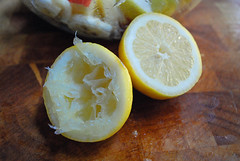As avid readers (because there are some, right??) know, Jack McAuliffe, the acknowledged founder of the craft brewing movement, is a friend. In January, Boston Beer Company --- known to you as Sam Adams --- will introduce New Albion Ale, based on the recipe Jack used to make his first beer in the late 1970s.

That means that lately there’s been an unusual amount of attention paid to Jack and to his brewery, New Albion. Which means that I’ve been hearing more than the usual iterations of a question I’m often asked: “Is New Albion really important?”
By which the questioner means:
“Hey, McAuliffe’s brewery only lasted a few years. Most people interested in craft beer had never even heard of the guy until your book came out. He can’t be that important.”
To which I usually say something like
“He deserved the credit. Would someone else have done what he did? Eventually. But at the time, he inspired others to do what he’d done, namely cobble together some raw materials, build a brewery, and make beer.”
(And I mention Ken Grossman and Sierra Nevada as an example of the direct influence of Jack and New Albion.)
So that’s the background. (Yeah. You know me: The background takes more time than the main point. What can I say? I’m a historian. Context is everything.)
Anyway, this has been on my mind. Or, more accurately, my brain has been busy pondering the “Would someone else have done what he did?” I say “apparently” because I didn’t realize I was even thinking about this until yesterday, when the following crashed into my brain’s foreground and grabbed my attention:
When people have asked me the aforementioned question, I’ve usually skipped over the “would someone else have done what he did” part and spoke mainly to the “direct influence” part of why Jack matters. Because of course I had no idea if someone else would have done what Jack did.
Until now. Thanks to my busy brain, I now have a different take on the issue of “does Jack matter?” (*1) It goes like this.
It’s hard to imagine that a craft brewing industry wouldn’t have shown up eventually, right? After all, at the same time that craft of beer pioneers were doing their thing, the “good coffee” movement started. Other entrepreneurs were experimenting with a return to good bread. Micro-distilleries began showing up in the early 1990s. Natural foods were going great guns in the 1980s.
So at some point someone would have come up with a “craft brewing industry.” (*2)
BUT: it’s not clear to me that, without Jack (or some one like Jack) it would have looked like the do-it-yourself, self-reliant industry that it was and to a certain extent still is.
Let me explain:
Jack’s brewery failed, but the way he built his company became the foundational model for the craft brewing industry that emerged in the early 1980s.
Ken Grossman, for example, had already dreamed about opening a brewery, a dream inspired in part by his love of good beer but also by a visit to Anchor Brewing in San Francisco. But when Ken visited Anchor, he saw an insurmountable obstacle: a full-blown brewery with “real” brewing equipment. Grossman knew he couldn’t pull that off, or at least not until he’d devoted a few decades to saving the many thousands of dollars such a venture would require.
When he visited New Albion, however, he saw instantly that here was a model that he could emulate and do so with relatively little cash. (He and his then-partner Paul Camusi scrounged $50,000 in start-up funds, mostly from family.) If he could find spare parts, which was what Jack had done, he could use his engineering/carpentry/handyman skills to build a brewhouse.
So he did, and so did other early pioneers, and the rest, as the cliche goes, is history.
But let’s ponder an alternative history, one based on a combination of speculation and fact.
Here’s a fact, one based on my six years spent thinking and writing about meat in America:
Food and food fads are like anything else: if there’s a profit to be made, if there’s a fad to ride, someone will jump in and try to make some money on it.
In the 1980s, for example, a couple of marketing types in California noted the interest in “natural” foods and began selling “Rocky the Ranger” chickens, which they touted as free-range and natural. The chickens weren’t, but that didn’t matter. Plenty of people were willing to pay big bucks for natural poultry. (Among them was Wolfgang Puck, just then hitting his stride and his celebrity, who began serving Rocky at his restaurants. He was none too pleased to discover, during a blind taste test, that neither he nor other tasters could tell the difference between high-priced Rocky and plain ol’ chicken).
Here’s another, more relevant example:
In the mid-1980s, Jim Koch, then working at Boston Consulting Group, had a early-mid-life crisis and decided he needed a job with more soul than helping Fortune 500 types figure out how to make billions rather than millions. Brewing was in his family (as he’s fond of pointing out, he’s the fifth generation to work in beer), and when he pondered his future while perched on a barstool, he noticed that yuppies, as they were called then, were dropping serious money to pay for imported beer (think Heineken and St. Pauli).
That market niche intrigued him. After a bit of investigation, Jim learned that there were a handful of people scattered around the country making what amounted to nineteenth-century beers (real, pure, made from four ingredients, blah blah blah). There, Koch decided, lay his future. In this case, he skipped the do-it-yourself route and instead contracted to brew his lager using “real” brewmasters at “real” breweries.
Jim Koch happens to be a guy with a soul. (*3) The company he built melds with and has been a key component of the craft beer industry.
But it’s clear that what Koch did, some other suit-and-tie could have done, too. (*4)
Which brings me, finally, to my point. (Thanks for sticking with me).

Had Jack McAuliffe not built his whacky, nineteenth-century-inspired, spare-parts brewery, a craft beer industry would have emerged anyway. But it likely would have been built by suits-and-ties; business types with more interest in profit than beer who’d wangled bank loans and built a brewery along the same lines as conventional brewing (read: Anheuser Busch) except in miniature. And then, I’m guessing, sold to the first big brewer who came along (and remember that both Miller and AB “came along” and started buying/acquiring shares in small fry in the late 1980s).
Instead of the “think local/think pure and real” craft brewing industry we’ve got now, with all its glory, creativity, and dynamism, we’d have ended up with a bastardized version in which the Big Boys made a few shitty “craft” beers, and instead of the few thousand breweries that now exist in the U. S., we’d probably still have, oh, 79 or 80. And I doubt we’d have locally owned and operated brewpubs. We might have chain restaurants with brewing equipment prominently displayed behind glass, but that’s not quite the same thing as the truly fascinating, truly local brewpub culture that has flourished in the U. S. in the past 30 years.
So. Jack matters not because he succeeded --- he didn’t --- but because of the way he built his company: from scraps, with next to no cash, and with a truckload of heart, soul, and hard work.
End of great idea.
For now. Part of my busy brain has been thinking hard about a new book and what it wants to write (and why would I get in its way!?) is a book about, well, I’m not quite sure yet but something about the craft beer industry, the nature of contemporary capitalism, the shift to the local, and the way all things digital have transformed all of it. I have the feeling I’m going to be thinking this book out loud, if you will, here at the blog. So it’s possible that this is a tentative first step toward this vague, amorphous, and possibly bad idea that’s churning around in my brain. We’ll see.
And comments and feedback are most welcome. Have at it.
Oh: And no, not quite finished with meat book. But I have written a major chunk of that pesky new chapter my editor wanted.
UPDATE AFTER THE FACT: I should have included this link first time around. Two years ago, Jay Brooks and Natalie and Vinnie Cilurzo went to the New Albion site with Jack. Jay made sure to document the visit.
__________
*1: I’m continually impressed by how much work my brain does without me even asking it to. Brains are important, you know? If we have a Mother’s Day and a National Pizza Day, and a “Talk Like A Pirate” day, why in hell don’t we have a “Thank Your Brain” day?
*2: Hmmm. That raises a fascinating question that I only thought of while writing this blog entry: How long would it have taken Charlie Papazian to go the next step; to travel from homebrewing-as-national-movement, which was what he was primarily interested in in the late ‘70s and early ‘80s, to “let’s take homebrewing to the next step”?
*3: Some would disagree with that view. But I would argue that one need only look at the way he’s operated his company to know that when he said he intended to build a corporation with a heart and soul, he meant it.
*4: Indeed, the essence of the messy craft beer boom of the 1990s was precisely that: suit-and-tie types bringing in big money to cash in on what was then seen as a profitable market niche.



